The SAP Best Practice Scam: How SAP Uses Best Practices to Control the Implementation
Executive Summary
- SAP uses the false assumptions of best practices to control accounts.
- Best practices assumptions damage the project from beginning to end.
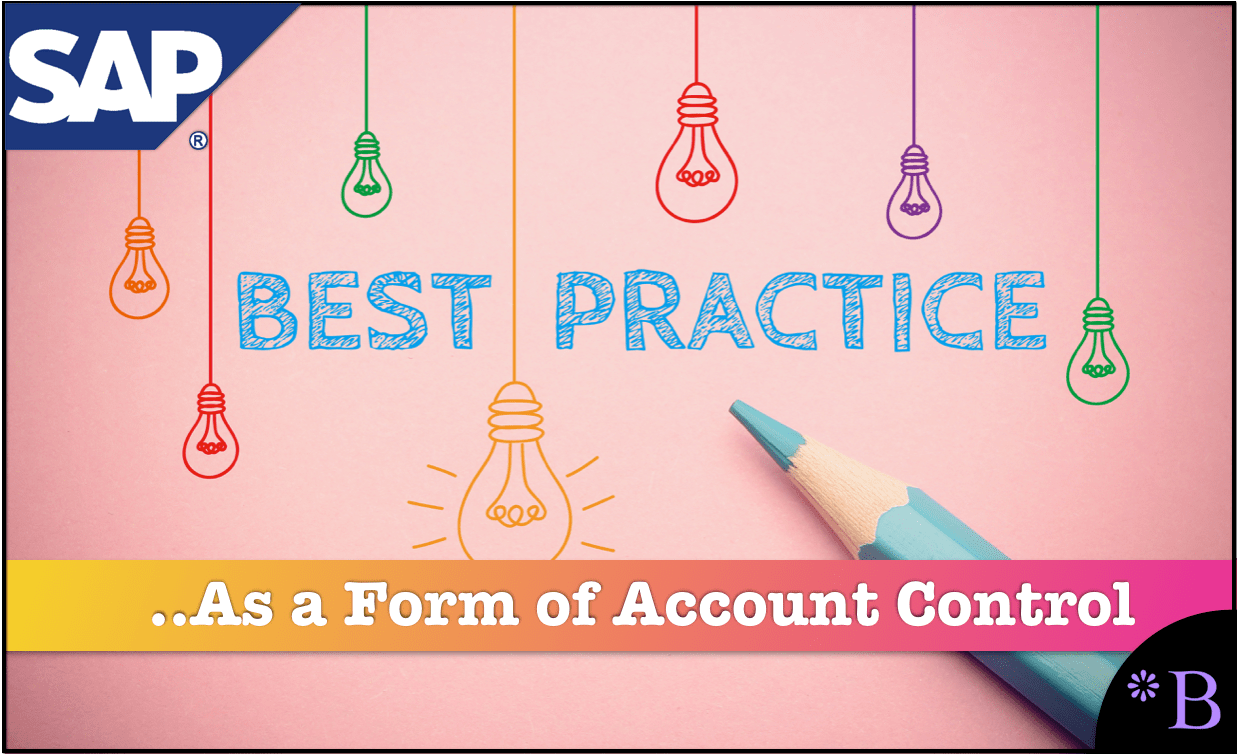
Introduction
SAP lists best practices in several areas on its website. I have included the following screenshot of best practices from this web page.
Our References for This Article
If you want to see our references for this article and other related Brightwork articles, see this link.
SAP’s Presentation
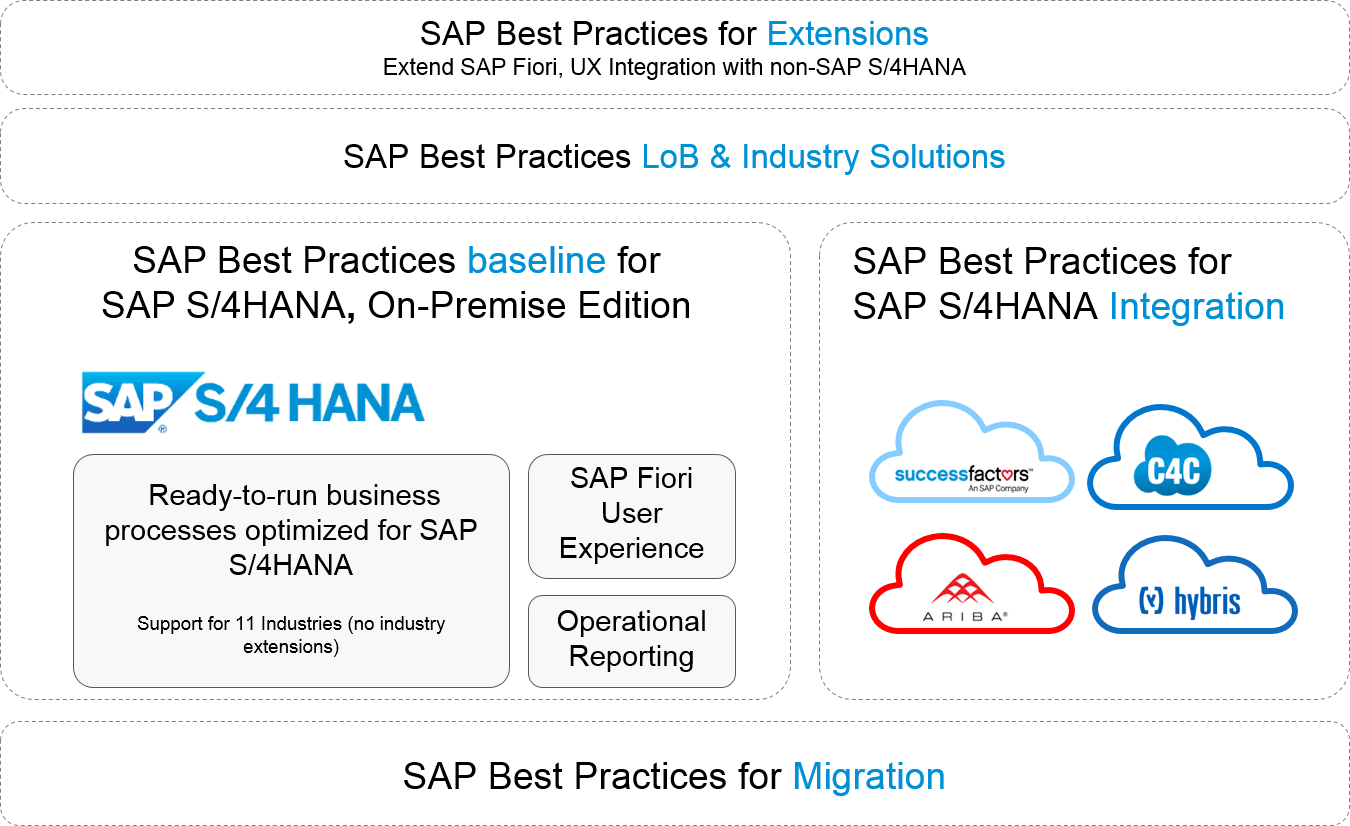
Here, SAP claims that all best practices are included in their software because they are so big. Secondly, they propose that customers who use best practices have been able to reduce consulting costs by 50 percent and reduce mistakes.
But, wait one second; aren’t best practices naturally inherent within SAP?
Does one have to choose between a best practice implementation and a non-best practice implementation?
What constitutes a best practice implementation?
This is all extremely confusing, as well as logically inconsistent.
Understanding the Presentation of SAP Best Practices
It’s essential to know how SAP presents best practices to its customers.
To enhance this understanding, here are some screenshots from SAP’s presentations. I was amazed at what I found from this presentation because what is presented here by SAP has no relationship to what occurs in SAP implementations.
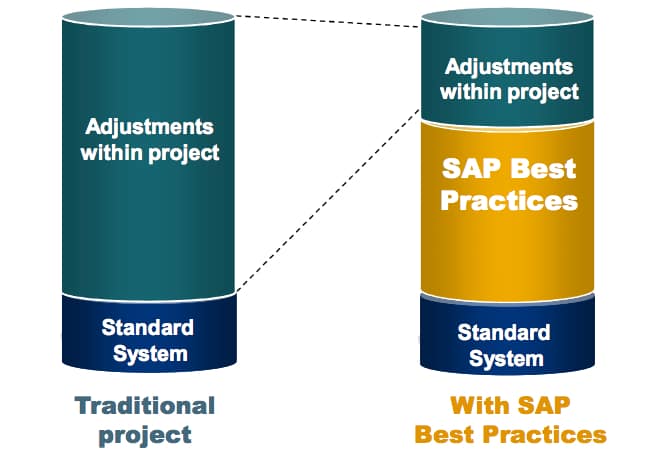
Here you can see SAP proposing that SAP best practices can reduce the adjustments necessary to the software. In an implementation, a company brings its requirements. Then those that the software cannot meet are either removed from scope, or they are accommodated with an enhancement or by buying another application. SAP never recommends the second option, which is purchasing another application, but nearly always pushes the client in the direction of enhancement and enhancement written in ABAP, even though a non-SAP coding platform may be better in many cases.
This is the text which accompanies the slide above:
SAP Best Practices are packages that provide preconfigured business processes and project accelerators to streamline customer implementations. – SAP
A best practice is not anything that is described above. Instead, it is functionality in the software that is supposed to be the best way to perform a business process. This sentence is very concerning because, firstly, best practice functionality is not provided by SAP. Still, this sentence implies that there are other things that SAP offers to their clients that are not part of the software but also best practices. It makes me wonder how much time people in sales in SAP spend in the software they are selling.
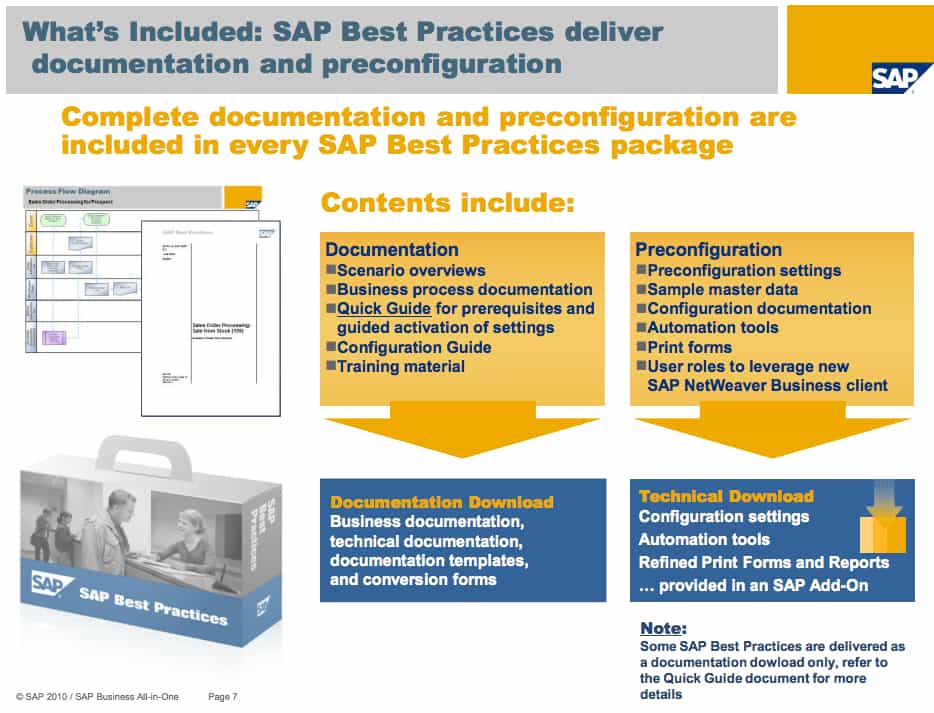
All vendors offer documentation and guides for how to implement their software. However, they are generally not called “best practices.” Again, best practices are supposed to be contained in the software themselves. They are not the manuals for the company. SAP is defining best practices so broadly here, that it appears that everything they offer is a best practice, and nothing is not a best practice. They list automated tools on this slide, which, again, I have never seen on a project. Finally, they finish off with a graphic of a box. So now SAP best practices are something you can pick up and take with you on your projects I suppose.
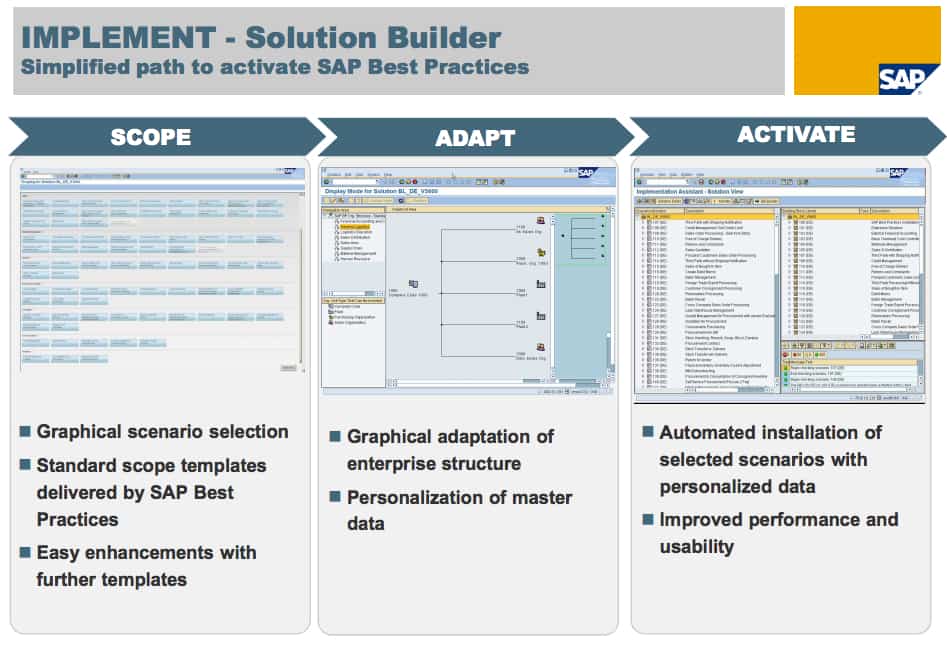
This looks interesting, but I have never seen these things on a project. I would be concerned if this is presented to a client, and then, as an implementor, I am expected to gain all these benefits from “Solution Builder” when, in fact, it will not even be used on a project. SAP is very time-consuming to configure and is the most challenging system I have worked with. However, this message misrepresents how difficult it is to configure SAP, and proposing these solutions will significantly ease my task. This is consistent with much of SAP’s messaging, that SAP is amazingly easy to put in and already has most of your business process or something even better (best practices) already in the application. This is simply delusional. People who write these things must spend time on an SAP project.
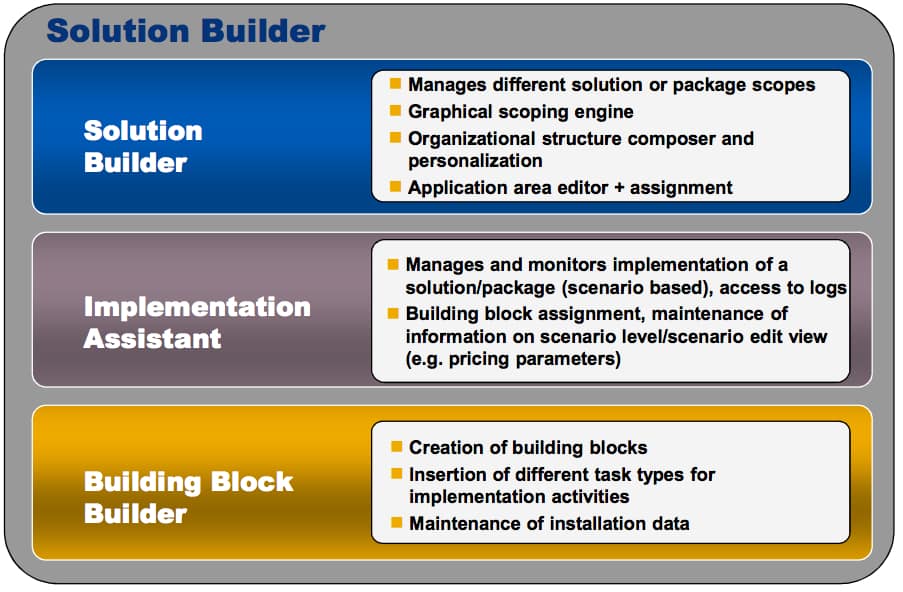
This slide shows three things I am supposed to be able to leverage to improve the implementation. One is the Solution Builder. The next is the Implementation Assistant. The final one is the Building Block Builder.
I have never seen any of these tools on a single project I have worked on.
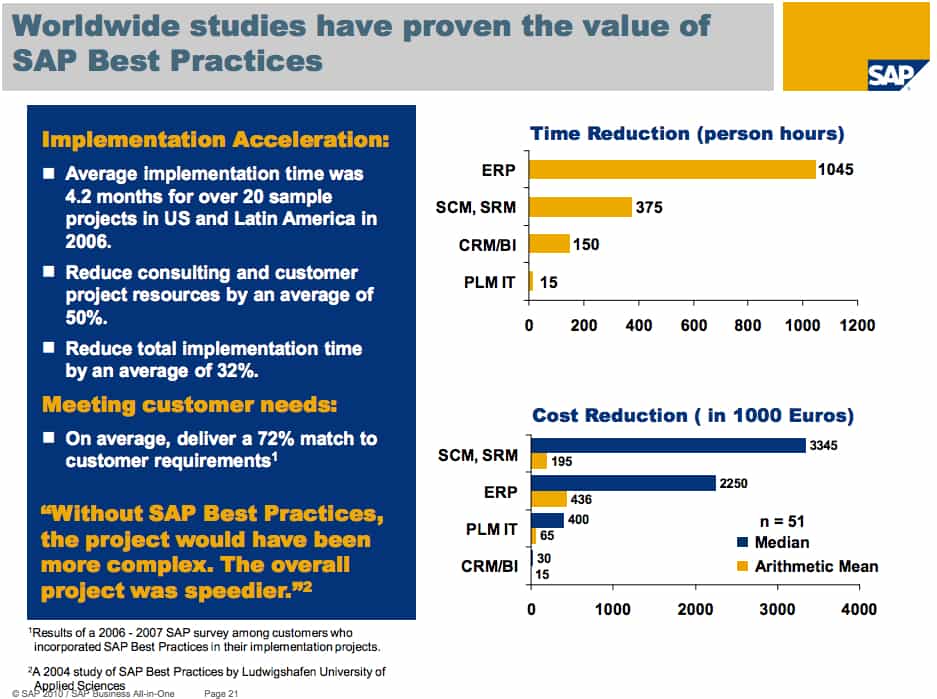
The average implementation time for an SAP project is now 4.2 months?
That is interesting.
I should note that this study goes back to 2006, 2007 and 2004. Therefore it cannot be that my information is out of date. I don’t see SAP projects going live faster than a year, and I arrive on many projects where the module has been live for several years and is still not delivering very much value because it was either a poor choice for the business or because it was never appropriately configured in the first place. These numbers are entirely made up. Before I read this presentation, I was unaware that all of these best practice accelerators were also used on projects; that is how little consequence “best practices” described in this presentation have on actual SAP implementations.
The individuals who made this presentation are not living in reality and are not talking to or listening to the people inside of SAP who implement software. The presentations were developed from a marketing angle but are so divorced from reality that they cross the line into fiction. In some ways, the presentation serves as a comedic document. Still, the document is not that amusing because companies may read this information and think there is some truth to it. Then, when they implement it, people like me will have to explain why none of the information in the document is correct. This is a constant issue with sales and marketing departments, in that they are continually disseminating false information that then has to eventually be contradicted by people who did not publicize the incorrect information, to begin with. When that happens, marketing and sales are nowhere to be found and are often retelling the same false story to new customers.
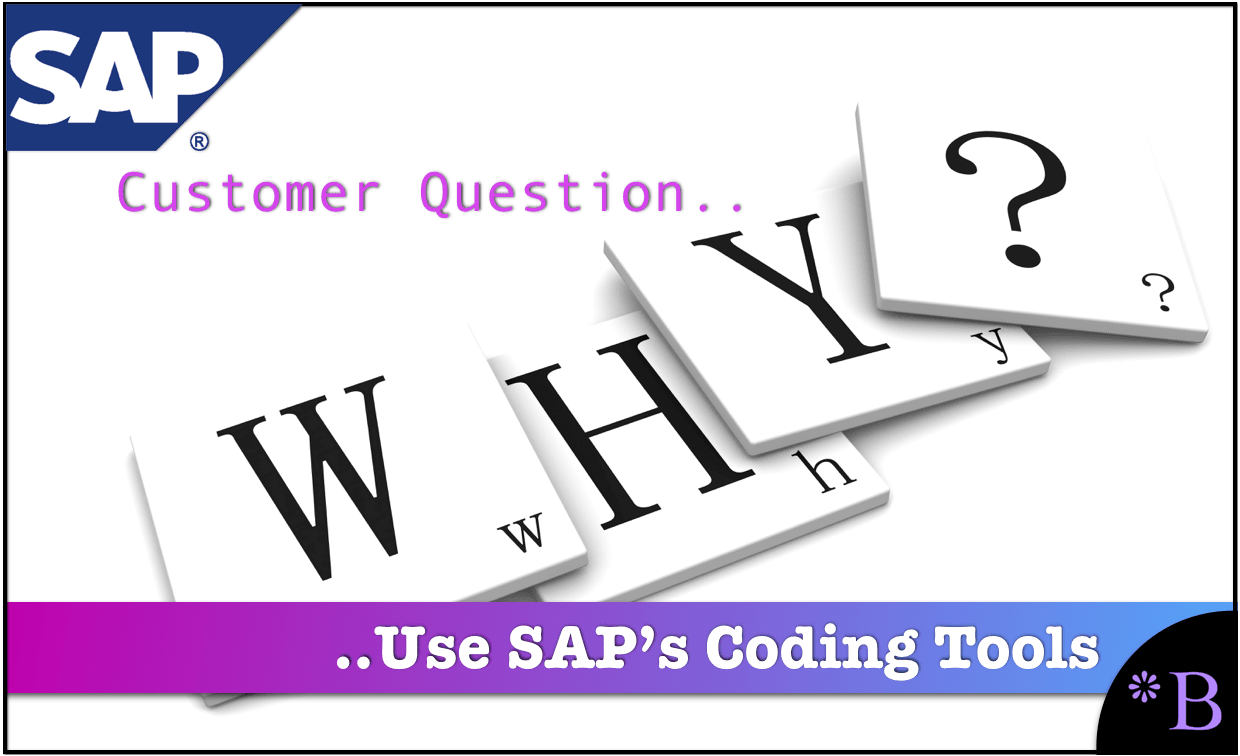
We cover this problem in detail in the article Why SAP Customers Followed SAP’s Advice on Coding in ABAP.
Not Performing A Proper Software Selection
The presentation of SAP best practices is a method for SAP sales to lull their potential clients into not performing a thorough comparison of their business requirements versus what SAP software can do, versus what competing applications can do. When you ask SAP consultants about SAP functionality, they are always cautious about positioning SAP as the default choice. Any critique about the ineffectiveness of SAP applications’ functionality is met with the benefits of integration into SAP.
The enterprise software market is inefficient, with most companies selecting the wrong software for their needs. I described demand planning software in this Why Companies Select the Wrong Demand Planning Systems.. One reason is that companies do not perform a thorough software selection, and another reason is that they rely upon biased and corrupt consulting companies like Accenture or IBM. These companies have long-standing relationships with vendors that they recommend to clients no matter how they fit with the clients’ requirements. Large consulting companies cannot perform an honest software selection, as I described in the article Why Big Consulting Firms Cannot Do Software Selection.
In essence, SAP is asking its potential clients to forget to properly compare different enterprise software and trust their statement that all the best practices exist in SAP in any case, “So what is the point of actually performing a software selection?”
SAP Best Practices and SAP’s Marketing Machine
On some projects, through the years, I have noticed the term “SAP best practices” used by SAP quite frequently. In the beginning, It always struck me as a bit curious, but on the other hand, I never gave it much thought. As I describe in this post, SAP has what I think is the world’s most excellent enterprise marketing machine. SAP’s best practices are part of its strategy for business development. SAP uses some marketing concepts for business development to gain, keep, and maintain market clients in the marketplace.
A best practice is one of these.
It’s important to understand that SAP marketing messages work to get SAP clients and control their software interpretation during implementation and after going live.
However, later in this article, I will show that SAP is not based upon best practices; secondly, in SAP’s documentation, they are confused about what a best practice is.
How Large Consulting Firms Misuse the Term Best Practices
SAP is not the only company that uses the term as a marketing construct and for business development. Prominent consulting firm consultants also like to use the term in a way that is almost always misleading. I once worked as a consultant at IBM who created a custom fix for a safety stock problem in a way that was the worst practice and then proposed that weekly delivery frequency was the “best practice.” This is somewhat amusing as this consultant was so technical he was almost a development resource and would not know a business best practice if it hit him in the head. This is, in fact, my view of most of the IBM consultants that I have met who work in IBM’s SAP practice. In their SAP practice, IBM consultants have good technical skills but mainly lie to clients regarding their business knowledge.
IBM also promised many best practices from their “vault in Armonk,” however, one of the client’s major complaints is that IBM did not seem to offer any, even though this was a significant focus on the overall sales presentation to the client. The only best practices that the client received were made-up to obtain buy-in on decisions the consultant wanted to go his way. They had nothing to do with a large data sample of companies that showed that one way of doing something was superior to another.
After working with IBM several times, I can confidently say that their best practices are fake.
Best Practices as a Legitimate Concept?
The concept behind best practices is that there is one best way of doing something. That is, if a user creates and interacts with a purchase order in a system, there is one best way to view, manage, and process that purchase order. SAP claims that their software is built around best practices because they are so large that they can say they have “standardized” their software on the best practices.
The concept is used in multiple ways on accounts:
- To initially sell the software.
- To control the implementation process and guide the client into using the SAP way of doing things.
- To shut down disagreement on the part of users.
- To prevent executives from analyzing why users are unhappy with the implementation.
What is unknown by most of the population is that the concept of best practices has been thoroughly analyzed in academic research and found invalid.
Fake Best Practices
Best practices sound suspiciously like something that one is asked to take on faith— and they are. Eugene Bardach, a professor of public policy, analyzed claims of best practices in his field and found that best practices are not based on research.
“Appearances can be very deceiving. On closer inspection, it often turns out that the supposedly ‘good’ practice is not solving the problem at all. Inadequate measurement plus someone’s rose-colored glasses were simply producing the illusion of mitigating the problem. It may also turn out that, even if good effects have truly occurred, the allegedly ‘good’ practice had little or nothing to do with producing them.”
The further one gets from actual implementation, and the less experienced one has with working with software, the more likely one is to believe that software can encapsulate best practices. Because the term “best practices” is so general, it does read a book on dishonest argumentation. This is a good indicator that something is wrong with the information that is being researched.
Another topic is related to the overall idea of best practices.
At first sight, the logic of best practices as propagated by consultancies seems irresistible: by copying practices of the worldwide mose successful companies, drawing on consultants’ experiences, one can improve one’s performance. However, some authors warn that the practice of implementing best practices is not as easy as consultants insinuate. Thus, Sandal argues that “one of the most pervasive and damaging follower afflictions that has increasingly infested corporate psychology is a disease known as best practicism. He attributes the causes of this disease to a number of erroneous beliefs, among them the belief that best practices are easier and less risky and the belief that the best practices can easily be transferred from one company to another. In a similar vein, Wareham and Gerrits question whether best practices remain best practices when transferred to another context.
Considering the problems in identifying best practices and in transferring them it is somewhat astonishing that best practices are given such a prominent role in consultancies’ communication. – Trading “Best Practices” – A Good Practice?, Industrial and Corporate Change
The Car Versus Truck Best Practice Example
Let’s take the example of two automobiles: one sedan and one truck. I own a Honda Accord but have been considering buying a four-wheel-drive Toyota Tundra. These are two very different automobiles built for various purposes. Both score very well in reliability, which I consider a best practice; I prefer high-quality cars that require infrequent repairs. However, could the fact that they both use an internal combustion engine and pneumatic tires be considered best practices? These are two of the most important inventions in human history, so I suppose I would not object to calling them best practices.
But on the other hand, every car I look at offers the same thing, so while they are best practices, they are not differentiators. Am I interested in comparing best practices that are not differentiators? I would say probably not. The Toyota has four-wheel drive, which can be a best practice if you intend to take the car off-road, but it is an unnecessary and extravagant option if one does not expect to use the vehicle in this manner. Four-wheel drive decreases gas mileage, and the knobby tires required to go off-road ride roughly on a paved road. So, should I sell my Honda and buy the Toyota? There are several factors, such as how much I will be using the vehicle for commuting versus taking my jet ski to the lake and going camping.
The vehicle’s benefits to me change depending upon the situation. Some best practices, such as reliability, are essential to me but maybe less important to other people. For instance, neither of these is exceptionally stylish. However, the Land Rover is stylish and has the best four-wheel drive practice. If anyone has ever sat inside a Land Rover with a leather interior, we can agree that their interiors are a best practice (that is, they feel very nice). To get the stylish ride, one has to pay a great deal more and give up the Japanese reliability for English reliability.
So, how do I decide on my vehicle with all these competing best practices?
I hope I have shown that there is a reason that people don’t take the concept of best practices to buying an automobile or really to any other purchasing decision, and this is because the idea is ridiculous. People look for a series of trade-offs in characteristics until they find a desirable compromise and then make their purchase decision. It does not happen now, and will not occur in the future, that your friend will announce that he based his decision to purchase a new car on best practices.
Best Practices in Which Software?
I used the example of cars because almost everyone has, at some point, decided to purchase a vehicle and because cars are relatively easy to understand. However, the concept of best practices is equally unhelpful and even problematic in making distinctions between things we do not know. As my expertise is supply chain software, I know that making supply chain software decisions based on best practices does not make any sense. This is elementary for me because I have spent more than a decade and a half analyzing and configuring supply chain software and working with it almost daily. However, because I don’t know much about accounting software if someone were to propose that accounting software be purchased based upon best practices, it would seem to be a strong statement, but only because I do not have the content expertise to analyze the claim truly. Indeed, some things in accounting software are desirable and could be deemed “best practices.” For instance, it is advisable that the program post the actual quantities entered into the database rather than using a random number generator. It is desirable that the program not crash and delete the last five hundred accounting entries. However, once we get past the relatively common functionality areas, there will be considerable debate about best practices.
How SAP Uses the Concept of Best Practices
I didn’t spend enough time listening to or reading SAP’s marketing message because it took a conversation with an industry analyst to explain that SAP hides behind the concept of best practices to defend weaknesses in its software.
The basic strategy is that SAP prepares their executives for complaints about their software by priming their executives to think that any complaints are because the users are resisting the best practices in the software. The sentence may be something akin to the following:
“You may receive push back on the system, but that is a change management issue because your employees are resisting the best practices that are in the software.”
This way, SAP’s software deficiencies are deflected back on the user.
Is SAP 100% Built on Best Practices? 50%?
The question should be, what evidence has ever been presented that SAP software only contains best practices? The answer is that no evidence ever is usually provided, at least when the claim is made orally, which is where it ends in most circumstances. However, you can find several SAP resources on best practices. I have entered a screenshot below of best practices.

As you can see, SAP claims that because they are so big, they have all best practices included. Secondly, they propose that customers who use best practices have been able to reduce consulting by 50% and reduce mistakes.
However, wait one second. Aren’t best practices naturally inherent within SAP? Does one have to choose between a best-practice implementation and a non-best-practice implementation? Secondly, SAP implementations are the most expensive implementations on the planet. If one wants to reduce consulting time or expenses, SAP would be the absolute wrong solution. It raises the question, “What exactly are best SAP practices?” Here is another screenshot on the topic of best practices.
“SAP Best Practices Based Upon Netweaver—SAP Best Practices provide a toolset that helps IT and functional project team members to quickly deploy functionality in SAP solutions—from SAPNetWeaver, to core SAP applications. The toolset comprises a mix of step-by-step instructions, pre configuration, sample master data, code samples (where applicable) and end-user training—organized by technical or business scenarios that you might want to implement in your landscape. Below you will find the SAP Best Practice versions that support the implementation of SAP NetWeaver components.” – SAP
Best Practices in……Master Data?
Here, you can see that SAP is now classifying best practices as a toolset made up of instructions, pre-configuration, and sample master data. But let us back up a few steps here. What do best practices have to do with the master data? Best practices are supposed to be business process functionality that is baked into the system. Master data should be kept up to date and validated with the business; however, this is not something you can bake into the application unless you mean making the software transparent and easy to use. Still, in that case, you are enabling a best practice; you are not modeling a best practice yourself.
Overall, this seems more like a jumpstart toolkit. The paragraph goes on to say that there is a NetWeaver component to best practices.
However, how can this be? NetWeaver is essentially the SAP (PI, ABAP, Basis) infrastructure components, so what do these have to do with business process functionality best practices? If by best practice SAP means ease of use or sustainable infrastructure tools, then SAP products are based upon worst practices. Because of all the infrastructure I have worked with, SAP takes the longest to do the essential things. Also, one questions how serious SAP is about their NetWeaver best practices because all of their links to supporting content on this page are broken.
The answer is that SAP does not know and is confusing them. They like to use the term liberally, but they use it in so many ways their usage is not consistent with the term’s meaning. They started by saying one thing with best practices, which was initially false even in that instance, and then their product management could not control themselves. They just began applying the terminology to a variety of initiatives just for the fun of it.
World Class = Best Practices = Digital Transformation?
Interestingly, such unsubstantiated statements are pretty common either in SAP or outside of SAP. The following quotation demonstrates this.
“A few years ago I had a meeting with a marketing director of a well-known consumer goods brand who proudly told me about the world-class stage-gate product process they had introduced.
How many successful new products have you launched as a result of this process, I asked?
Well, none, he replied, but the process is world-class, he insisted.”– Dr. Ken Hudson
If you want to make something sound tantalizing, but you have zero evidence that it is, in fact, beneficial in any way, give it some generalized positive label — best practice, world-class, best-in-class, super-duper — the choice is yours. As many business communities are unthinking zombies, the technique is amazingly effective in almost any domain.
Ahh, the new term for his is digital transformation, a term as meaningless as best practices, as we cover in the article The Problem with the Term Digital Transformation.
Confusion on Best Practices by SAP
The worst-case scenario is that SAP employs marketers who can’t keep their stories straight and have limited English and logical foundations. Also, one question is how serious SAP is about their NetWeaver best practices because all of their links to supporting content on the web page were broken when I reviewed this material.
The answer to these questions?
SAP does not know; they are confused about how to use the term “best practices.” Like cream cheese on a bagel, SAP smears the term on almost everything they do. With SAP, directly calling standard SAP documentation a “best practice” will somehow (magically) allow projects to go live much more quickly. In this case, the best practice is incantation. Taking a vendor seriously is challenging when they are undisciplined about their terminology. SAP finishes the proposal by declaring that best practices enable SAP implementations to go live in 4.2 months.
This is not true; in all my years working with SAP, I have never seen any SAP module go live in 4.2 months. This is another problem with credibility: SAP implementations are measured in years—not months—and anyone who works in SAP knows this. So, where is this number coming from, and what module is SAP talking about? Where is the evidence for this? No evidence is ever presented.
The Negative Effect of Best Practice Claims on Projects
If only best practice claims ended when the software was sold, that would be one thing; however, the conversations regarding best practices passed from sales to the consultants are supposed to make good on these claims during the implementation. When you repeatedly tell customers they will get best practices in every dimension if they buy your software, unfortunately, they don’t forget this.
As with any promise that can’t be fulfilled, SAP consultants are put in an awkward position. I would know—I have been one of these consultants. The term “best practice” becomes a punch line on many of my projects. The individuals in the implementing company realize that there is no such thing as best practices.
Jokes such as,
“But wait…it’s okay because it has best practices,”
or,
“All we need on this project is just more best practices!”
..are quite common. They do not know this because marketing and salespeople don’t work on projects or with software. After realizing that they had been deceived by SAP Sales (accompanied by a healthy dose of cynicism about best practices), I heard senior members of my client declare..
“We don’t want to hear anything more about best practices.”
In the implementation phase, best practices lose all credibility.
Non-ERP Uses of the Term “Best Practices”
SAP is certainly not the only company that uses “best practices” as a marketing construct for business development. Consultants from large consulting firms also like to use the term and use it in a way that is almost always misleading. I once worked with a consultant who created a custom adjustment for a safety stock problem in an utterly inadvisable way. I would consider it to be the worst possible practice. He then proposed that weekly delivery frequency was the best practice. He suggested that any technique he wanted to employ was a best practice. I learned that twice-a-week delivery was a best practice; who knew that how frequently a product is delivered could be a best practice?
It isn’t.
Consulting companies continually use the term “best practices” to sell work. However, as with best practice claims made by ERP vendors, no evidence exists that what the consultants promote as a best practice is that, and this is because they have no proof; it’s an opinion. It’s one thing to say that this or that is one’s opinion from experience. But it’s something else to gusset up this opinion as a best practice—with zero evidence—simply because one would like their opinion to carry more weight. It is also expected to hear from the client that the consulting company did not seem to offer best practices once they were on the project. The reason is simple enough: once one gets into the details of the actual recommendation, they look a lot less like “best practices” than they did from a distance.
Criticizing Pre-existing Systems
Best practices have been beneficial to ERP vendors in permitting them to criticize a potential customer’s pre-existing systems. Sales and marketing are about changing perceptions to encourage a purchasing decision. One way of doing this is to increase the item’s purported virtues to be purchased (in this case, the ERP system). Another way is to lower the perceived value of the customer’s current item. They are using the term “legacy” to describe all previous systems — which is another technique SAP uses that we cover in the article How SAP Used and Abused the Term Legacy. The term “best practices” to describe ERP systems is highly effective and an impressive feat of rhetoric because it ignores the critical fact that the legacy system had been customized for the business requirements while the ERP system had not.
Essentially, ERP vendors appealed to a central concept: how things are done in other organizations must be better than how things are done in the potential customer’s company. This reversals the “not invented here” philosophy, which proposes “anything not invented here.” This is explained in the following quotation:
“ ‘Don’t assume newer is necessarily better,’ advised Project Manager Ellen Harmon of the Washington State Community and Technical Colleges Center for Information Services. Harmon considers her existing legacy system to be just another, older ERP. ‘We actually have an ERP that has been developed over the last 18 to 20 years for specifi c clients, and because of that, this ERP is very focused on these particular client needs.’ The case is the same at other universities.‘Their legacy systems have been developed to meet their specific needs and are tailored to their environment,’ said Harmon. ‘An ERP vendor might say your system is old, and therefore is bad, and we will sell you this new system. But it is a legacy system, too.’ ” – Promise of ERP System
This quotation raises an interesting question: what is the definition of “legacy”? An ERP vendor may be selling a system with an older code base than the “legacy” system it is replacing.
Interestingly, the designs of many of the ERP applications sold today are incredibly dated, and yet they are never referred to as “legacy.” To a software salesman, other people’s systems are legacy, but your systems are never. One might ask why this is the case.
The reason is not hard to determine. “Legacy” is a term of propaganda applied to systems that the designator would prefer to denigrate as a pretext for proposing another system. If you work in ERP Sales, all pre-existing systems in the companies you would like to sell your ERP software are legacy. No matter how dated, the ERP system you are selling is never referred to as legacy. Therefore, the term “legacy” has two meanings: the actual definition (“an old method, technology, computer system or application program”) and the real sense—any system that you would like to replace. However, many decision-makers missed an essential detail of infrastructure technology management, as explained in the following quotation:
“IT analysts estimate that the cost to replace business logic is about fi ve times that of reuse, and that’s not counting the risks involved in wholesale replacement. Ideally, businesses would never have to rewrite most core business logic; debits must equal credits—they always have, and they always will. New software may increase the risk of system failures and security breaches.” – Wikipedia
Many companies have relearned this fact about computer systems. Many of the cost overruns of ERP systems were related to replacing business logic.
Considering the SAP Best Practices Claims in Light of Their Actual Software R&D
I have worked in SAP APO since 2002 and never found anything in APO that did not exist in other vendors before SAP put it into APO. Other vendors have adopted cost optimization, allocation, and the statistical forecasting methods used by DP, everything in all the modules. However, if we broaden the search for novel functionality for ERP, we can see that MRP and DRP were well established before SAP adopted them.
There is nothing new in SAP BW either. SAP is one of the few vendors partnering with smaller software companies to co-opt their technology and build their products from it. So SAP has copied its functionality from everywhere.
However, I don’t think that is what SAP means when they refer to best practices.
Evidence That SAP Software Is Not Based on Best Practices
It’s clear that SAP primarily relied upon its customer base to justify best practice claims. Secondly, I am aware of many areas of SAP that are not best practices. Here are some examples:
- SAP APO SPP uses DRP functionality to perform something called inventory balancing. However, DRP is no longer the best approach to achieving this business process. The best practice is to use multi-echelon functionality. DRP plans all facilities as if they are independent of one another, which is a less accurate planning method and not an accurate reflection of reality. However, the problem is that SAP APO does not have it, while several best-of-breed vendors do.
- SAP APO DP has a few examples of implementations using the characteristic-based planning functionality. This is because it is so difficult to configure that it rarely is. It is also very weak in attribute forecasting. It is so infrequently used that one could question if DP is an attribute-based forecasting tool. I have used Demand Works Smoothieto to enter attributes into different columns in an import spreadsheet or database table. This allows for extremely easy-to-change attributes, which is unheard of in SAP APO DP.
- SAP APO SNP only has one method to use service level to control stocking levels, which is dynamic safety stock. However, that is no longer the best practice. The best practice is to use inventory optimization, which SAP does not have but best or breed vendors do have.
- BW can neither quickly make changes to the underlying data structures to support changes in the business nor provide best-practice analytics. SAP would probably say they have fixed this issue with purchasing Business Objects. However, Business Objects also lacks best practices compared to competitors such as Tableau. Secondly, SAP claimed to have a best practice data warehouse when they only owned BW. So, if they already had all the data warehouse best practices, why did they repurchase Business Objects?
- PP/DS uses cost-based optimization and heuristics to develop the plan. However, neither one of these approaches is currently a best practice. Cost-based optimization has failed to succeed as an effective way of performing production planning and scheduling. While better than purely manual methods, heuristics are of low average effectiveness. Currently, the best practice in production planning and detailed scheduling is performing time or duration-based optimization. However, SAP lacks this functionality. Other vendors have moved ahead of them, and SAP offers old, less effective technology to its clients and pretends it’s on the leading edge.
These are just a sampling. The areas in which SAP software does not have best practices go on and on.
Best Practices as a False Construct
The idea that SAP contained best practices was never accurate. SAP often offered many ways to configure a system, so SAP contradicted itself as this would have to be called best practices or multiple best practices per process. There are many ways of doing things that aren’t even excellent practices, much less “best.” I conclude that SAP’s best practices are just a marketing concept that looks good in PowerPoint presentations. The less you know about SAP, the more it seems like best practices may exist in SAP.
The fundamental problem with the concept of best practices is that there can be no final agreement as to what a best practice isn’t. Secondly, when SAP or any vendor, for that matter, declares that they have all the best practices, it must be understood that this is a self-bestowed title. Self-bestowed titles don’t have any meaning. It would be like me naming myself the best dancer in Atlanta. But at least there is some competition I could enter to prove such a thing. There is no best practices competition held and no official body that approves certain practices over other practices and names them “best.”
I am still waiting for the software vendor to advertise that they only have the worst practices in their software.
Therefore, part of the reason that SAP used the term legacy was to criticize their customers’ existing systems without explicitly analyzing them. And SAP’s solution?
Well, this is two-fold.
- In many cases, simply eliminate the in-house software and move to SAP’s “best practices.” In SAP’s considered opinion, none was necessary as SAP’s software did everything correctly anyway. Anything the customer had come up with was the wrong way of doing it. This was true even if SAP did not have the specialized functionality that was developed over what was, in many cases, decades by the customer.
- Port all the logic from open programming languages to their ABAP programming language.
Our Golden Pinocchio Award

SAP gets our Golden Pinnochio Award for false claims with its repeated claims around best practices.
The Truth of Best Practices in SAP
Best practices have been pitched as a central premise for SAP marketing efforts for some time. SAP is not the only company to do this. As I described in an earlier article, IBM and many other consulting companies present the idea of best practices primarily as a way to get business and as a way to control the implementation.
“I once worked with a consultant at IBM who created a custom fix for a safety stock problem in a way that was really a worst practice, and then proposed that weekly delivery frequency was “best practice.” IBM also promised a large number of best practices from their “vault in Armonk,” however, one of the major complaints of the client is that IBM did not seem to offer any, even though this was a major focus of the overall sales presentation to the client.”
Therefore, IBM consultants often use the term “best practices” for configuration decisions. However, IBM does not offer its clients the best practices that it has supposedly picked up from all its experience, although IBM salespeople say they do.
Who Makes These Best Practice Claims and Why?
SAP Marketing and Sales make best practice claims. The best practices that SAP describes should be categorized as sales techniques. They have no validity on an actual project. The way to evaluate enterprise software is whether it has specific functionality that addresses the needs or business requirements.
Using the term best practices interferes with this analysis and places a false schema on top of the analysis that needs to be done. SAP Sales and Marketing is now simply smearing the term, like cream cheese on a bagel, on almost anything with SAP. This includes calling standard SAP documentation a “best practice” that will somehow (magically?) allow projects to go live much more quickly. The SAP presentation finishes by declaring that best practices enable SAP implementations to go live in 4.2 months, which is not the average, but in all my years working with SAP, I have never seen any SAP module go live in 4.2 months anywhere at any time.
The Effect of Best Practice Claims on Projects
Another problem is that SAP’s best practice claims put SAP consultants in a difficult bind. This is true whenever one is asked to justify something untrue. SAP consultants arrive on projects with these enormous and false best practice claims on the software. The consultants are then forced to explain that one still has to gather requirements and determine what parts of the requirements can be covered by standard SAP functionality and which cannot. All of the best practice claims made by SAP sales and marketing do not change what must occur on the project.
Conclusion
The best practices that SAP describes should be categorized as sales techniques. They have no validity on an actual project.
The way to evaluate enterprise software is to determine whether it has specific functionality that addresses the needs or business requirements. Using the term best practices interferes with this analysis and places a false schema on top of the analysis that needs to be done. Best practices are all over SAP sales literature, as described in An Analysis of SAP’s Messaging on Best Practices, and are used frequently by consulting companies. Still, on actual projects, they mean very little.
SAP uses unsupported marketing concepts for business development in several major categories of its message to companies, but best practices might be the most effective. First, the statement does not hold up against any SAP software analysis. Second, it is dangerous to assume that any software vendor is telling the truth that they have all the best ways of doing things already programmed into their business logic, so you don’t have to worry or question.
Secondly, SAP is not clear about what best practices are themselves and does not even take the time to keep the links to the topics updated. The more honest vendors set their software to be flexible enough to do things differently and then use their consulting resources to figure out the best way for the particular client. SAP cannot follow this approach because the software design is inherently inflexible, and thus, there is a need for the brilliant sleight of hand known as “SAP best practices.” What “best practices” actually mean is that SAP is right. That SAP has designed its system in the best way, and other ways are wrong. Mostly, clients buy this, and consultants have adopted the concept of “best practices” because it reduces their necessity to present evidence.
Instead of being hypnotized and distracted by the term best practices, companies should get into the details of what software can and cannot do. Secondly, it needs to match that analysis with what the company wants to do. Looking for software vendors to tell you what to do is a mistake. Your business needs to know what it wants to do, and if it is following poor practices, it needs to hire the right people or bring in the right external business expertise to improve these processes.
Best practices have been a deep well that ERP vendors have repeatedly drawn from to support multiple objectives.
ERP vendors do not attempt to hire professional researchers to validate their claims regarding best practices because
- a) Most of what they propose is how their software works—and is not a best practice, and
- b) Customers generally don’t question the best practice claims made by ERP vendors.
Generally, all that is needed to convince companies that a software vendor has best practices is if it has marketing documentation that declares best practices, is generally successfully selling its software, and has significant brand recognition.